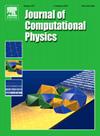利用双曲线戈杜诺夫-佩什科夫-罗缅斯基模型对相变进行数值模拟
IF 3.8
2区 物理与天体物理
Q2 COMPUTER SCIENCE, INTERDISCIPLINARY APPLICATIONS
引用次数: 0
摘要
本文提出了戈杜诺夫、佩什科夫和罗缅斯基的一阶双曲连续体模型(GPR 模型)的界面黎曼问题的热力学一致数值解。在存在相变的情况下,界面物理受微观尺度上分子相互作用的支配,超出了体相宏观连续模型的范围。所开发的近似两相黎曼求解器通过结合局部热力学模型来预测界面熵的产生,从而解决了这一多尺度问题。利用非平衡热力学的现象学关系,从熵的产生推导出界面质量通量和热通量,并提供相边界的封闭性。我们在一个高效的尖锐界面水平集 Ghost-Fluid 框架中采用了所提出的黎曼求解器,为相变下的相界面提供耦合条件。作为单相基准,我们研究了雷利-贝纳德对流,以比较 GPR 模型的双曲热松弛公式与双曲-抛物线欧拉-傅里叶系统。利用 Lennard-Jones 移位和截断势对蒸发冲击管进行分子动力学模拟,验证了新型界面黎曼求解器。在宏观尺度上,计算了正十二烷材料的蒸发冲击管,并与欧拉-傅里叶结果进行了比较。最后,通过涉及相转移和表面张力,同时具有严重界面变形的冲击-液滴相互作用模拟,证明了该方案的效率和稳健性。本文章由计算机程序翻译,如有差异,请以英文原文为准。
Numerical simulation of phase transition with the hyperbolic Godunov-Peshkov-Romenski model
In this paper, a thermodynamically consistent numerical solution of the interfacial Riemann problem for the first-order hyperbolic continuum model of Godunov, Peshkov and Romenski (GPR model) is presented. In the presence of phase transition, interfacial physics are governed by molecular interaction on a microscopic scale, beyond the scope of the macroscopic continuum model in the bulk phases. The developed approximate two-phase Riemann solvers tackle this multi-scale problem, by incorporating a local thermodynamic model to predict the interfacial entropy production. Using phenomenological relations of non-equilibrium thermodynamics, interfacial mass and heat fluxes are derived from the entropy production and provide closure at the phase boundary. We employ the proposed Riemann solvers in an efficient sharp interface level-set Ghost-Fluid framework to provide coupling conditions at phase interfaces under phase transition. As a single-phase benchmark, a Rayleigh-Bénard convection is studied to compare the hyperbolic thermal relaxation formulation of the GPR model against the hyperbolic-parabolic Euler-Fourier system. The novel interfacial Riemann solvers are validated against molecular dynamics simulations of evaporating shock tubes with the Lennard-Jones shifted and truncated potential. On a macroscopic scale, evaporating shock tubes are computed for the material n-Dodecane and compared against Euler-Fourier results. Finally, the efficiency and robustness of the scheme is demonstrated with shock-droplet interaction simulations that involve both phase transfer and surface tension, while featuring severe interface deformations.
求助全文
通过发布文献求助,成功后即可免费获取论文全文。
去求助
来源期刊

Journal of Computational Physics
物理-计算机:跨学科应用
CiteScore
7.60
自引率
14.60%
发文量
763
审稿时长
5.8 months
期刊介绍:
Journal of Computational Physics thoroughly treats the computational aspects of physical problems, presenting techniques for the numerical solution of mathematical equations arising in all areas of physics. The journal seeks to emphasize methods that cross disciplinary boundaries.
The Journal of Computational Physics also publishes short notes of 4 pages or less (including figures, tables, and references but excluding title pages). Letters to the Editor commenting on articles already published in this Journal will also be considered. Neither notes nor letters should have an abstract.
 求助内容:
求助内容: 应助结果提醒方式:
应助结果提醒方式:


